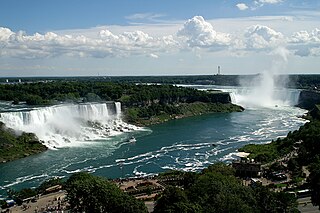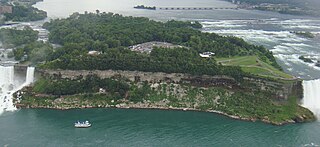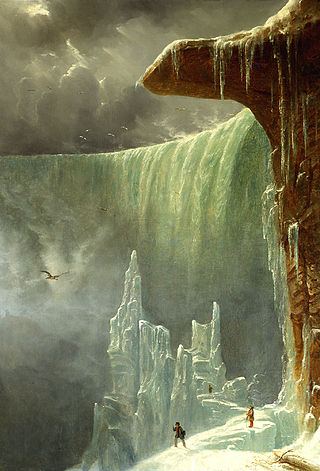
Niagara Falls is a group of three waterfalls at the southern end of Niagara Gorge, spanning the border between the province of Ontario in Canada and the state of New York in the United States. The largest of the three is Horseshoe Falls, which straddles the international border of the two countries. It is also known as the Canadian Falls. The smaller American Falls and Bridal Veil Falls lie within the United States. Bridal Veil Falls is separated from Horseshoe Falls by Goat Island and from American Falls by Luna Island, with both islands situated in New York.

The American Falls is the second largest of the three waterfalls that together are known as Niagara Falls on the Niagara River along the Canada–United States border. Unlike the much larger Horseshoe Falls, of which approximately 90% is in Ontario, Canada, and 10% in the U.S. state of New York, the American Falls is entirely within the United States.

Horseshoe Falls is the largest of the three waterfalls that collectively form Niagara Falls on the Niagara River along the Canada–United States border. Approximately 90% of the Niagara River, after diversions for hydropower generation, flows over Horseshoe Falls. The remaining 10% flows over American Falls and Bridal Veil Falls. It is located between Terrapin Point on Goat Island in the US state of New York, and Table Rock in the Canadian province of Ontario. These falls are also referred to as the Canadian Falls.

Tightrope walking, also called funambulism, is the skill of walking along a thin wire or rope. It has a long tradition in various countries and is commonly associated with the circus. Other skills similar to tightrope walking include slack rope walking and slacklining.

Niagara Falls State Park is located in the City of Niagara Falls in Niagara County, New York, United States. The park, recognized as the oldest state park in the United States, contains the American Falls, the Bridal Veil Falls, and a portion of the Horseshoe Falls.

Bridal Veil Falls is the smallest of the three waterfalls that make up Niagara Falls. It is located on the United States side in New York state. Luna Island separates it from the American Falls and Goat Island separates it from the Horseshoe Falls. Bridal Veil Falls faces to the northwest and has a crest 56 ft (17 m) wide.

Goat Island is a small island in the Niagara River, in the middle of Niagara Falls between the Bridal Veil Falls and the Horseshoe Falls. The island is at the southwest corner of the City of Niagara Falls, New York, in the United States and is part of Niagara Falls State Park.

The Tower Hotel, opened in 1962, is located in the Fallsview district of Niagara Falls, Ontario and was the first of the contemporary observation towers built near the brink of the Falls. It features an indoor observation deck, restaurant, and hotel. The tower is 99 metres tall above street level and 160 metres above the falls. The tower assumed its present name in 2010 as a result of its most recent renovation; as Minolta was the longest-tenured sponsor of the building, tourists and locals may still call it the Minolta Tower.

The Cave of the Winds was a natural cave behind Bridal Veil Falls at the Niagara Falls. The cave was some 130 feet (40 m) high, 100 feet (30 m) wide and 30 feet (9 m) in depth. It was discovered in 1834, and originally dubbed Aeolus's Cave, after the Greek god of winds.

Ball's Falls also known as Balls Mills, Louthe Mills and Glen Elgin, is a historical ghost town located in what is now a part of Jordan in the Niagara region, Ontario, Canada, which dates back to the early 19th century. It is now preserved as a conservation area operated by the Niagara Peninsula Conservation Authority.

The Niagara Falls Suspension Bridge stood from 1855 to 1897 across the Niagara River and was the world's first working railway suspension bridge. It spanned 825 feet (251 m) and stood 2.5 miles (4.0 km) downstream of Niagara Falls, where it connected Niagara Falls, Ontario to Niagara Falls, New York. Trains used the upper of its two decks, while pedestrians and carriages used the lower. The bridge was the idea of Canadian politicians, and it was built by an American company and a Canadian company. It was most commonly called the Suspension Bridge, although other names included Niagara Railway Suspension Bridge, Niagara Suspension Bridge, and its official American name of the International Suspension Bridge.

Journey Behind the Falls is an attraction in Niagara Falls, Ontario, Canada located in the Table Rock Centre beside the Canadian Horseshoe Falls. It is open year round and run by the Niagara Parks Commission.

The Niagara Scow is the unofficial name of the wreck of a small scow that brought two men perilously close to plunging over the Horseshoe Falls, the largest of the Niagara Falls, in 1918. The wreck can still be seen, upstream of the falls.

Table Rock was a large shelf of rock that jutted out from the Canadian shore of Niagara Falls, Ontario, just north of the present day observation and commercial complex. Revealed in the mid-18th century as the Horseshoe Falls receded, Table Rock was the first major vantage point for tourists of the early and mid-19th century.

Cedar Island was a small, uninhabited and elongated island located in the Niagara River near the Canadian shore, opposite the Table Rock observation area at the brink of the Horseshoe Falls.

The Three Sisters Islands are islands which lie off the south shoreline of Goat Island. The islands are part of Niagara Falls, New York.

The Table Rock Welcome Centre is a retail and observation complex located in Niagara Falls, Ontario, Canada at the brink of the Canadian Horseshoe Falls, several hundred feet south of the former rock formation which bears its name. The complex consists of two buildings connected by an indoor pedestrian mall and anchored by "The Grand Hall", a multi-level indoor observation complex, completed in 2008.

William "Red" Hill Sr. was a Canadian daredevil and rescuer, born in Niagara Falls, Ontario, in 1888. In 1896 he received his first medal for bravery when he rescued his sister from their burning house which was followed by a life-saving medal in 1912, achieving the status as a local hero. A bootlegger on occasion during the Prohibition, Hill went on to receive a total of four medals in addition to being credited with saving 28 lives and the recovery of 177 accident and suicide victims from the Niagara River just below the Falls.

Nikolas Wallenda is an American acrobat, aerialist, daredevil, high wire artist, and author. He is known for his high-wire performances without a safety net. He holds 11 Guinness World Records for various acrobatic feats, and is best known as the first person to walk a tightrope stretched directly over Niagara Falls. Wallenda walked 1,800 feet (550 m) on a steel cable over Masaya Volcano in Nicaragua, his longest walk, on March 4, 2020.

The Casino Tower, formerly known as the Oneida Tower and Kodak Tower, is a 355-feet-tall open steel tower in Niagara Falls, Ontario, Canada. Designed by the architect Alan R. Moody, it was built in a matter of six months by Frankel Steel Company of Toronto in the busy tourist season of 1964.






















